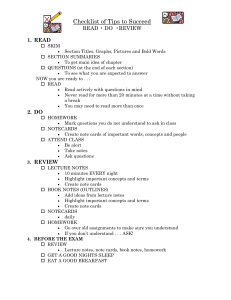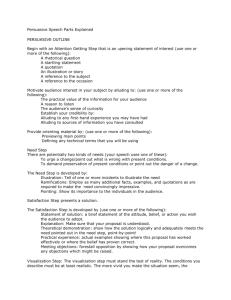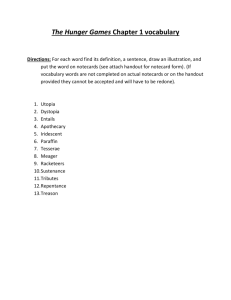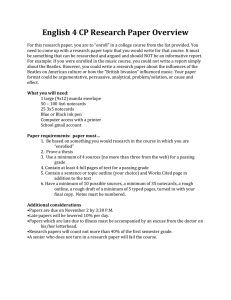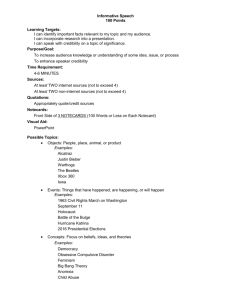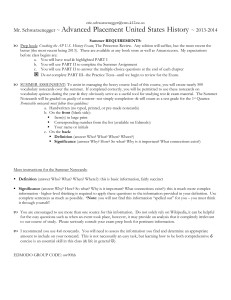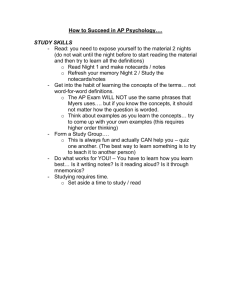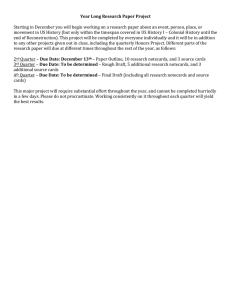Pers_Speech_Intro
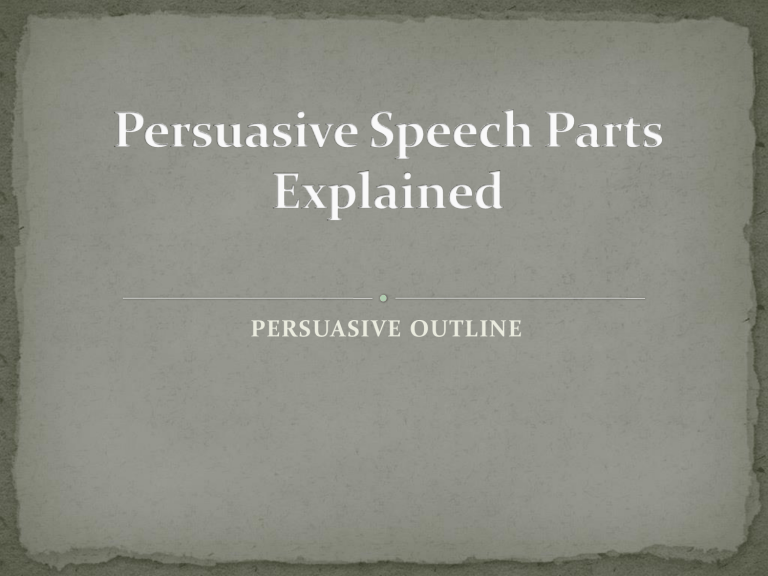
PERSUASIVE OUTLINE
MMS is an organizational pattern used to help the audience identify a problem, to provide a solution to that problem, and to help the audience get enthused about the advantages of that solution.
Monroe’s basic idea was that most people, when presented with a problem, will want to find a solution.
MMS is comprised of 5 parts:
1. Attention 4. Visualization
2. Problem
3. Solution
5. Action
Attention: Hey! Listen to me, you have a PROBLEM!
Problem: Let me EXPLAIN the problem.
Solution: But, I have a SOLUTION!
Visualization: If we IMPLEMENT my solution, this is what will happen. Or, if we don't implement my solution, this is what will happen.
Action: You can help me in this specific way. Will you help me?
Begin with an opening statement of interest: (use one or more of the following)
A rhetorical question (a question asked for effect that neither expects nor requires an answer)
A startling statement
A quotation
An illustration or story
A reference to the subject
A reference to the occasion
Then draw the audience in further by
Explaining the practical value of the information for your audience
Appealing to the audience’s emotions
Piquing the audience’s sense of curiosity
Establish your credibility by
Alluding to any first-hand experience you may have had
Alluding to sources of information you have consulted
Finally, provide orienting material by
Stating your thesis.
Previewing main points
There are two approaches to presenting the problem.
To urge a change - point out what’s wrong with present conditions
“We have a problem, so we need to change X.”
To demand preservation of present conditions point out the danger of a change
“If we change X, we could have a problem.”
Your speech should use one of these two.
A Statement: give a definite, concise statement of the problem.
Then use at least one of the following to get the audience to see your side of the issue.
Illustrations: give one or more examples illustrating the problem. This is where you try to “paint pictures” verbally to really get audience to understand the situation.
Elaborations: Employ as many additional facts, examples, and quotations as are required to make your argument convincingly impressive.
Pointing: Show how this problem is directly related and important to the audience.
Now that you’ve illustrated the problem, you want to offer a solution, develop it with the following steps.
Statement of solution: Tell your audience in a very specific, direct sentence what it is you want them to do. This is the FIRST time that you state this outright.
Explanation: Make sure that your proposed solution is understood.
Demonstration: Show how the solution logically and adequately solves the PROBLEM, point-by-point!
Practical experience: actual examples
showing where this proposal has worked effectively or where the belief has proven correct.
Meeting objections: Anticipate opposing
arguments and address them before the audience has time to actually bring them up.
“Even though Mrs. X believes Y, my solution is better because…”
Predict for the audience what will happen if your solution is carried out or what will happen if it isn’t.
While your visualization should be vivid, it must be realistic as well. Use one or more of the following three methods to get your audience to visualizing the future.
•
•
•
Positive
Negative
Contrast
Positive: Describe the conditions if your solution is actually carried out. Help the listeners picture themselves in that situation actually enjoying the safety, pleasure, or pride that your solution will produce.
Negative: Describe conditions if your solution is not carried out. Get the audience to visualize the bad effects or unpleasantness that they will experience if they don’t enact your solution.
Contrast: Combination of 1 and 2. Begin with the negative method (undesirable situation) and conclude with the positive method (desirable solution).
Use one or more of the following:
Restate your main idea and summarize your main points.
State the specific action or attitude change you want from the audience.
State your personal intent to take the course of action or attitude recommended.
Give a concluding statement to recapture interest (a reason to remember). It should be brief, powerful, and well worded.
Thanks to Gary Cottle of Southeastern Community College in West Burlington,
Iowa for these notes
Your Speech should include appeals using
Pathos (emotion)
Ethos (experts and endorsments)
Logos (statistics and facts)
Your speech should be three minutes long
You will turn in your outline with your rubric.
Notecards: Only use brief notecards.
Speaking Focus: Practice connecting with the audience. There is a temptation to overuse notes on this speech. Be very familiar with your speech, especially the research, make sure your notecards are brief and easy to read.
